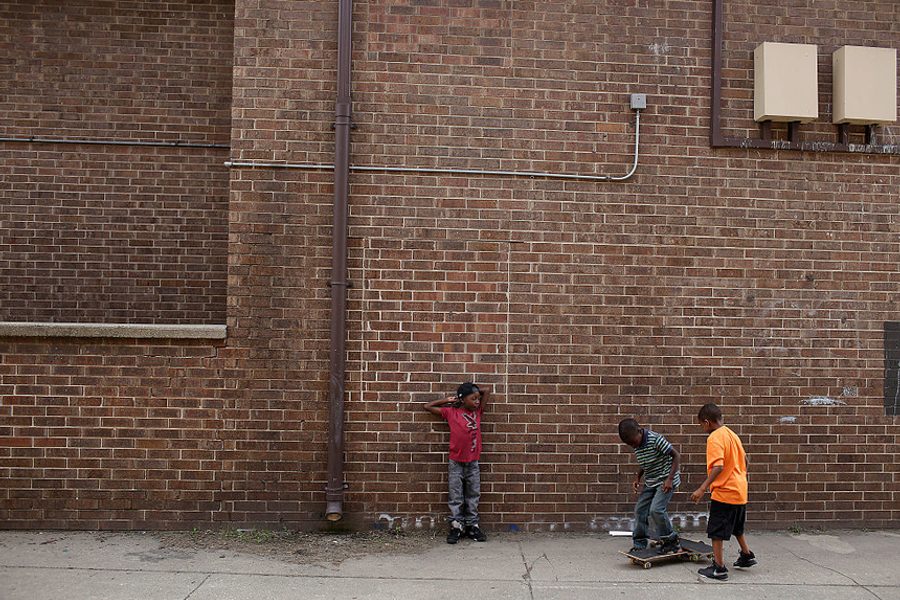Not Your Sacrifice Zone: In Lead-Poisoned East Chicago, Residents Fight for Their Health and Homes
A public housing development was built on the site of a lead smelter. Now, residents are demanding justice.
Kaela Bamberger

EAST CHICAGO, IND. — As the U.S. Department of Housing and Urban Development (HUD) representative tried to explain that he was only responsible for the housing demolition, the crowd began to grumble. They wanted to hear about housing vouchers, the relocation of residents to pollutant-free homes and the long-term health impacts of living on lead-contaminated land.
This past April, the last of more than 1,000 residents were forcibly evacuated from the West Calumet Housing Complex, a public housing project built at the former site of a lead smelter, because of the high levels of lead in their yards. In order to get the area back to “residential standards,” HUD has been tasked with demolishing the complex, while the Environmental Protection Agency has been instructed to replace top layers of the surrounding soil.
This recent meeting, held hauntingly in a deserted elementary school in the most contaminated part of city, was a result of community demands for a voice in the demolition of West Calumet Housing Complex. HUD claims that the demolition would pose no health risks to the surrounding area. But East Chicago residents gathered on June 26 to demand a seat at the table and a full environmental impact assessment before the process begins.
When HUD Deputy Regional Administrator James Cunningham continued to dodge their questions, unrest stirred the crowd. The residents of East Chicago, Ind., have been dealing with bureaucratic side-stepping since the EPA put their town on the list of top-priority clean up sites in 2009.
“This was a hoax. This was an affront to the community,” says East Chicago resident Rev. Cheryl Rivera about the meeting. “They were not prepared at all to answer questions.”
Though more than 300 families have been displaced, those who remain have made it clear they will not accept lead-filled air, infrastructure, soil and water. More than 40 years of poisoned land is now taking its toll on the health of the community, which is over 90 percent African-American and Latino. The EPA learned of the lead contamination in 1985, but did nothing substantial about it until 2009, with residents still being invited to move into the housing complex until 2016.
The site of the housing complex is only one part of the story. The neighborhood as a whole is one of the most severely polluted in the country, with the rate of lead in the soil as high as 91,000 parts per million (ppm) in some locations. To put that in context, the EPA’s “acceptable” amount of lead to have in the soil is 400 ppm, although no amount of lead is safe to have in the bloodstream of children. The community is also subject to a host of other industry runoff, including arsenic and oil spills.
“These people have been trampled on, stepped on, disrespected, and allowed to move where illnesses still exist,” says community member Shirley Lowe.
“I want to be treated like a human being,” said Tara Adams after the meeting. “I want respect.”
Communities of color must deal with a disproportionate amount of the poisonous runoff of extractive industry, and the government is often slower to respond. During Mike Pence’s time as governor in Indiana, he ignored demands by East Chicago residents and the city’s mayor to declare a state of emergency, or even visit.
Compare this negligence to Greentown, Ind., a 97-percent white neighborhood that received immediate attention in 2016 from then-Gov. Pence to fix up the lead in the water of their neighborhood and high school. While the situation has been resolved in Greentown, the hits just keep coming for East Chicago: A new “confined disposal facility” (neutral language for toxic waste dump) is being pushed by the U.S. Army Corps dredging project to go less than a mile away from the East Chicago Central High School, despite past community protest for this location.
The city’s woes can be traced to extractive industry. East Chicago’s proximity to Chicago, the valuable iron ore from nearby Lake Superior and its own local limestone deposits have lured dozens of processing plants to settle in and around it.
“Okay, get this,” says Thomas Frank, who was fired years ago from his director position at East Chicago Waterway Management District for speaking out against BP. “The American Bar Association includes 30,000 environmental attorneys. Of those, 28,000 are employed full time by industry and corporations. Under 2,000 are employed by the government. And less than 600 are employed by nonprofits, some of which could be also [pro-]industry.”
“The whole system is stacked up against us,” he says. “We need to flip this whole chart around.”
Frank now organizes with Community Strategy Group, and their list of demands includes free, life-long healthcare for those affected by the lead and policy change around how much industrial waste is legally acceptable for residential areas. “We want to be making policy changes, we don’t want to do one-offs,” he says. That is, while individual reparations for East Chicago residents would be an immediate victory, it wouldn’t contribute to the current and future struggles of other poisoned communities with no easy path toward justice.
More recently, the adamant voices of community members seem to have gotten through. In a follow-up letter sent July 6, Cunningham of HUD promises that “the affected residents and the community at-large will be involved and provided opportunities to comment in several [upcoming] public meetings.” It is certain that the residents of East Chicago will be there, prepared to advocate for themselves once again.




